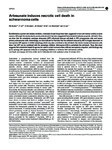Artesunate induces necrotic cell death in schwannoma cells
| dc.contributor.author | Button, RW | |
| dc.contributor.author | Lin, F | |
| dc.contributor.author | Ercolano, E | |
| dc.contributor.author | Vincent, JH | |
| dc.contributor.author | Hu, Bing | |
| dc.contributor.author | Hanemann, Clemens Oliver | |
| dc.contributor.author | Luo, Shouqing | |
| dc.date.accessioned | 2016-05-18T10:54:19Z | |
| dc.date.available | 2016-05-18T10:54:19Z | |
| dc.date.issued | 2014-10 | |
| dc.identifier.issn | 2041-4889 | |
| dc.identifier.issn | 2041-4889 | |
| dc.identifier.other | e1466 | |
| dc.identifier.uri | http://hdl.handle.net/10026.1/4649 | |
| dc.description.abstract |
<jats:title>Abstract</jats:title><jats:p>Established as a potent anti-malaria medicine, artemisinin-based drugs have been suggested to have anti-tumour activity in some cancers. Although the mechanism is poorly understood, it has been suggested that artemisinin induces apoptotic cell death. Here, we show that the artemisinin analogue artesunate (ART) effectively induces cell death in RT4 schwannoma cells and human primary schwannoma cells. Interestingly, our data indicate for first time that the cell death induced by ART is largely dependent on necroptosis. ART appears to inhibit autophagy, which may also contribute to the cell death. Our data in human schwannoma cells show that ART can be combined with the autophagy inhibitor chloroquine (CQ) to potentiate the cell death. Thus, this study suggests that artemisinin-based drugs may be used in certain tumours where cells are necroptosis competent, and the drugs may act in synergy with apoptosis inducers or autophagy inhibitors to enhance their anti-tumour activity.</jats:p> | |
| dc.format.extent | 0-0 | |
| dc.format.medium | Electronic | |
| dc.language | en | |
| dc.language.iso | en | |
| dc.publisher | Springer Science and Business Media LLC | |
| dc.subject | Apoptosis | |
| dc.subject | Artemisinins | |
| dc.subject | Artesunate | |
| dc.subject | Autophagy | |
| dc.subject | Cell Line, Tumor | |
| dc.subject | Chloroquine | |
| dc.subject | Drug Synergism | |
| dc.subject | Free Radical Scavengers | |
| dc.subject | Humans | |
| dc.subject | Necrosis | |
| dc.subject | Neurilemmoma | |
| dc.subject | Nuclear Pore Complex Proteins | |
| dc.subject | RNA-Binding Proteins | |
| dc.subject | Reactive Oxygen Species | |
| dc.title | Artesunate induces necrotic cell death in schwannoma cells | |
| dc.type | journal-article | |
| dc.type | Journal Article | |
| dc.type | Research Support, Non-U.S. Gov't | |
| plymouth.author-url | https://www.webofscience.com/api/gateway?GWVersion=2&SrcApp=PARTNER_APP&SrcAuth=LinksAMR&KeyUT=WOS:000344994000038&DestLinkType=FullRecord&DestApp=ALL_WOS&UsrCustomerID=11bb513d99f797142bcfeffcc58ea008 | |
| plymouth.issue | 10 | |
| plymouth.volume | 5 | |
| plymouth.publication-status | Published online | |
| plymouth.journal | Cell Death & Disease | |
| dc.identifier.doi | 10.1038/cddis.2014.434 | |
| plymouth.organisational-group | /Plymouth | |
| plymouth.organisational-group | /Plymouth/Faculty of Health | |
| plymouth.organisational-group | /Plymouth/Faculty of Health/Peninsula Dental School | |
| plymouth.organisational-group | /Plymouth/Faculty of Health/Peninsula Medical School | |
| plymouth.organisational-group | /Plymouth/REF 2021 Researchers by UoA | |
| plymouth.organisational-group | /Plymouth/REF 2021 Researchers by UoA/UoA01 Clinical Medicine | |
| plymouth.organisational-group | /Plymouth/REF 2021 Researchers by UoA/UoA03 Allied Health Professions, Dentistry, Nursing and Pharmacy | |
| plymouth.organisational-group | /Plymouth/Research Groups | |
| plymouth.organisational-group | /Plymouth/Research Groups/Institute of Translational and Stratified Medicine (ITSMED) | |
| plymouth.organisational-group | /Plymouth/Research Groups/Institute of Translational and Stratified Medicine (ITSMED)/CBR | |
| plymouth.organisational-group | /Plymouth/Users by role | |
| plymouth.organisational-group | /Plymouth/Users by role/Academics | |
| plymouth.organisational-group | /Plymouth/Users by role/Researchers in ResearchFish submission | |
| dc.publisher.place | England | |
| dcterms.dateAccepted | 2014-09-08 | |
| dc.identifier.eissn | 2041-4889 | |
| dc.rights.embargoperiod | Not known | |
| rioxxterms.versionofrecord | 10.1038/cddis.2014.434 | |
| rioxxterms.licenseref.uri | http://www.rioxx.net/licenses/all-rights-reserved | |
| rioxxterms.licenseref.startdate | 2014-10 | |
| rioxxterms.type | Journal Article/Review |


